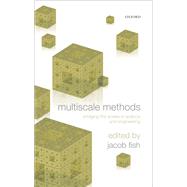
Note: Supplemental materials are not guaranteed with Rental or Used book purchases.
Purchase Benefits
What is included with this book?
| Preface | |
| Information-Passing Multiscale Methods in Space | |
| Mixed multiscale finite element methods on adaptive unstructured grids using limited global information | |
| Formulations of Mechanics problems for materials with self-similar multiscale microstructure | |
| N-scale Model Reduction Theory | |
| Concurrent Multiscale Methods in Space | |
| Concurrent Coupling of Atomistic and Continuum Models | |
| Coarse-grained molecular dynamics: Concurrent Multiscale Simulation at Finite Temperature | |
| Atomistic to continuum coupling | |
| Space-Time Scale Bridging Methods | |
| Methods of Systematic Upscaling | |
| Equation-free computation: an overview of patch dynamics | |
| On multiscale computational mechanics with time-space homogenization | |
| Adaptivity, Error Estimation and Uncertainty Quantification | |
| Estimation and Control of Modeling Error: A General Approach to Multiscale Modeling | |
| Error Estimates for Multiscale Methods for Multiphysics Problems | |
| Multiscale Software | |
| Component Software for Multiscale Simulation | |
| Selected Multiscale Applications | |
| Finite Temperature Multiscale Methods for Silicon NEMS | |
| Multiscale materials | |
| From Macroscopic to Mesoscopic Models of Chromatin Folding | |
| Multiscale Nature Inspired Chemical Engineering | |
| Table of Contents provided by Publisher. All Rights Reserved. |
The New copy of this book will include any supplemental materials advertised. Please check the title of the book to determine if it should include any access cards, study guides, lab manuals, CDs, etc.
The Used, Rental and eBook copies of this book are not guaranteed to include any supplemental materials. Typically, only the book itself is included. This is true even if the title states it includes any access cards, study guides, lab manuals, CDs, etc.